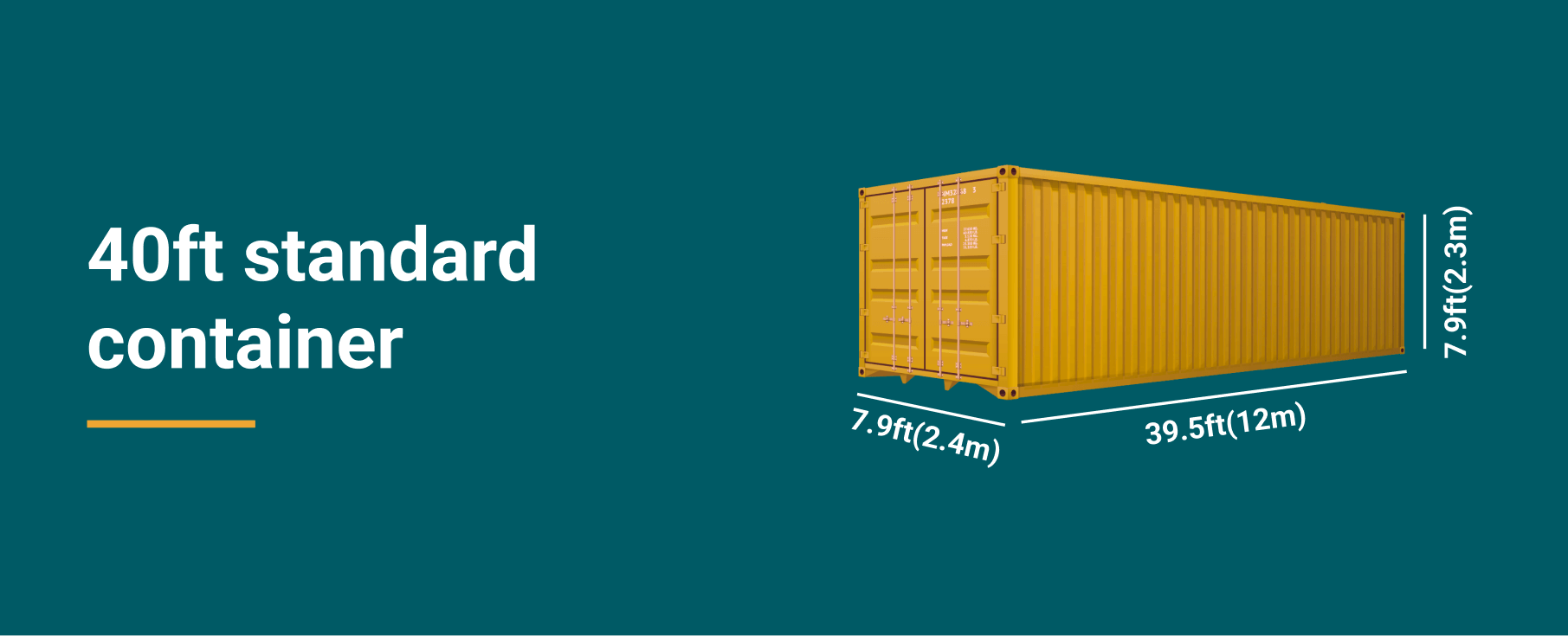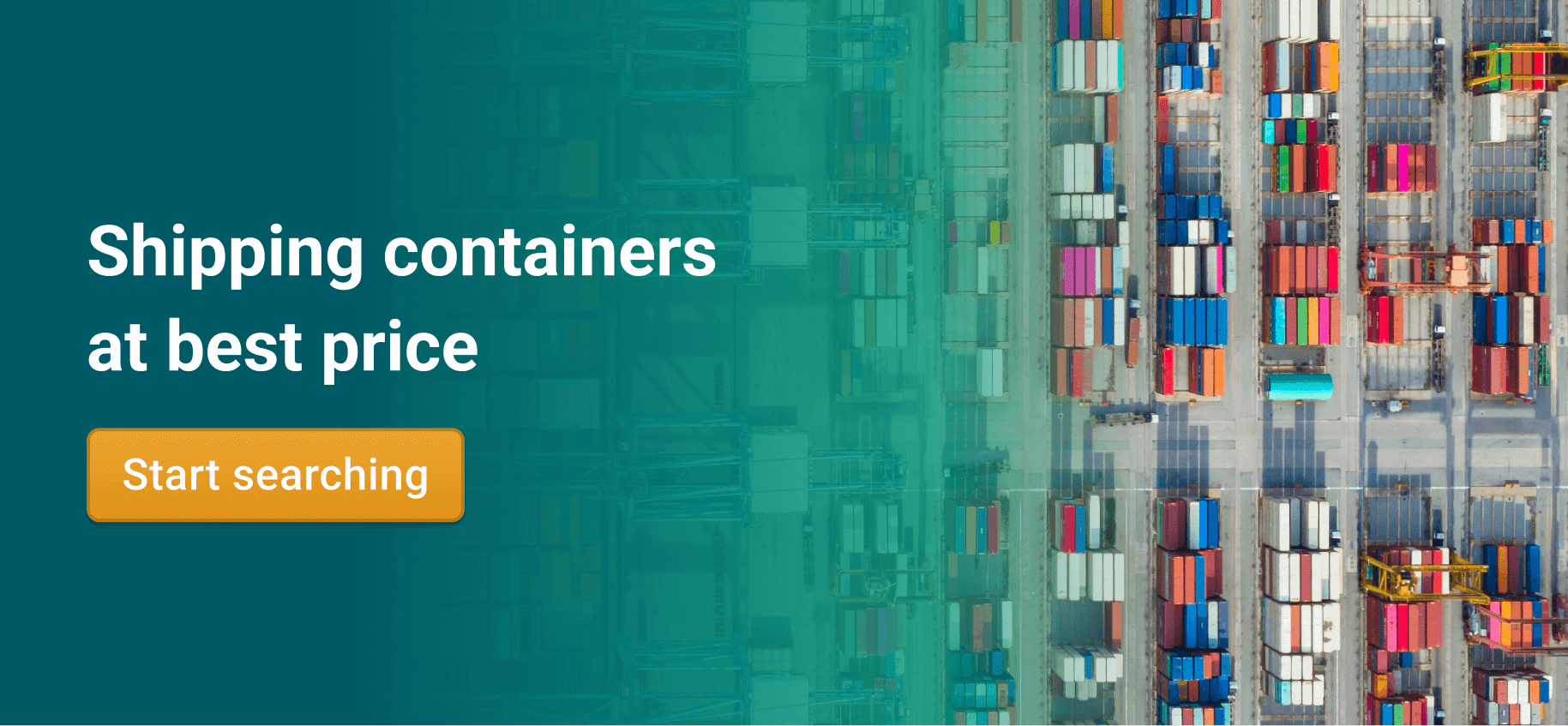Curious about standard shipping container? Read this blog to find out all about standard containers and where you can find these containers at the best prices.
Standard shipping containers are the most common containers in the shipping industry. The 20ft and 40ft standard containers are used to transport the majority of dry cargo across the globe.
It’s easy to get your hands on standard containers in the container market. But, with the lack of transparency in the industry, there’s no guarantee that you’re paying the right price for them.
That’s why we developed an online trading marketplace that offers 100% market price transparency. On Container xChange, you can browse, compare, and choose container offers directly from sellers. No need to rely on brokers anymore. We have 10,000+ containers available in 2500+ locations globally.
What’s more? Well, we don’t charge any commission on these deals. So you can be sure that you’re paying only the right price for your containers.
Ready to see container prices? Simply use the trading search below. Fill in the container type you’re looking for along with the location and start trading containers today.
What’s a standard shipping container?
A standardized container is the most common and basic type of freight container used for shipping cargo. They follow the ISO container specifications. You can transport your cargo safely in these durable containers, as they’re made of high-quality aluminum or steel. Plus, these sturdy containers are weather-resistant — fully-equipped to face the rough seas.
Also, you’ll get them at cheaper prices than others, making them a favorite for most in the industry. Standard containers have a high demand in the second-hand container market as well. They are available in different container conditions like cargo-worthy, WWT and As is in the container market.
These containers follow the standards set by the International Organization for Standardization (ISO). The ISO is the global body that develops and publishes technical, industrial, and commercial standards.
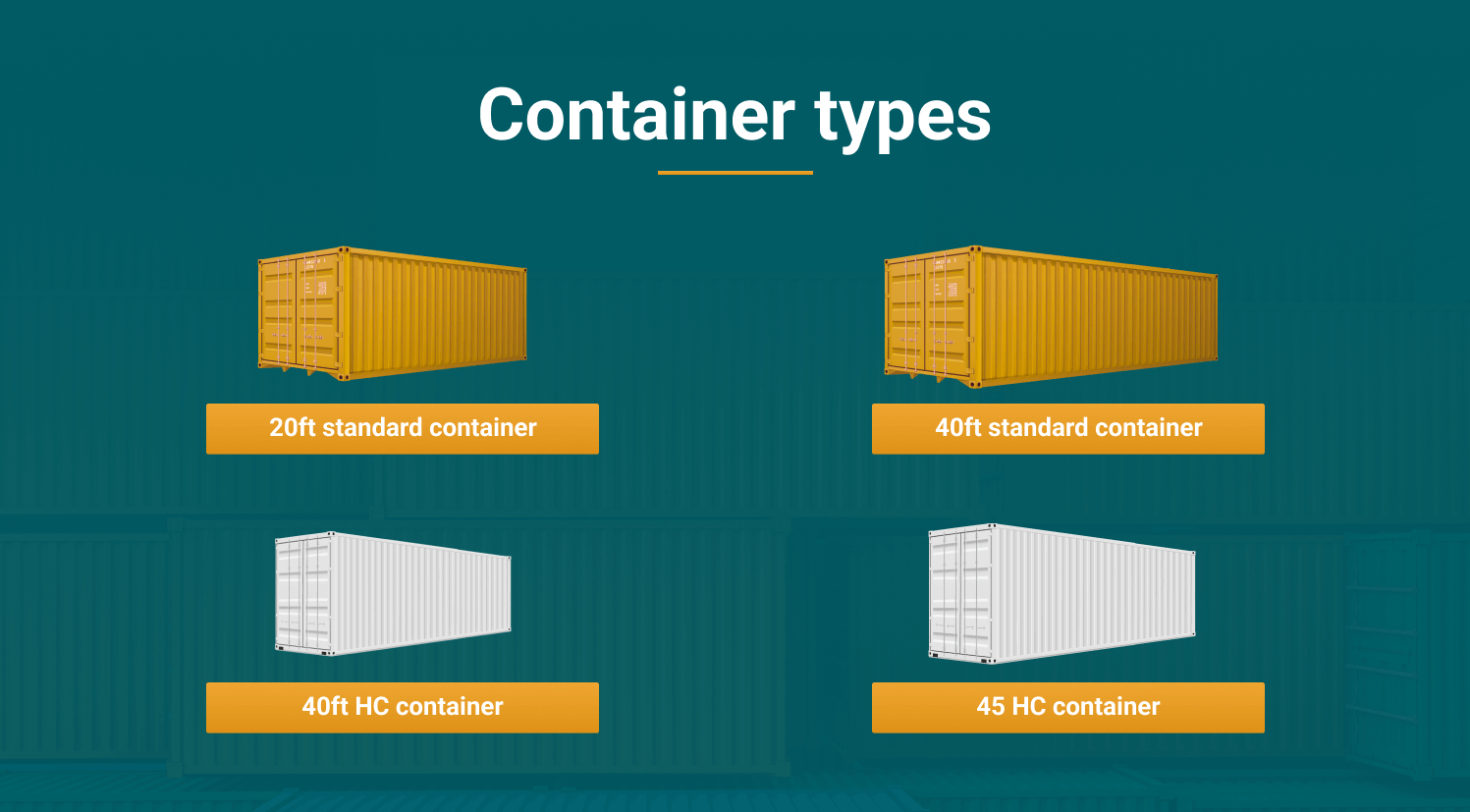
There’s no doubt that the standardization of containers revolutionized shipping. But how did containers get standardized in the first place? Read on to find out.
History of the standard shipping containers
Before the standardization of containers, the freight was handled manually. People would pick goods from a factory, load them onto a vessel, take them to a warehouse, and later to another vessel. Your guess is correct. This only led to poor coordination, massive delays, and a shortage of output!
But towards the end of the 18th century, people started using shipping containers for rail and horse-drawn transport in England. The US Army used it too for storing supplies during WWII.
And finally, in 1956, Malcolm McLean, an American businessman, manufactured the modern standard container as we know it now. After experimenting with the designs, he created the right container for seamless transportation across borders.
Standardization of containers significantly helped the global shipping industry. Read on to know why it created such a massive impact on global trade.
How did standardized containers improve shipping?
After the standardization of containers, it became possible for logistics, manufacturing and shipping companies all over the world to work together. Standardized containers cut the loading times by up to an astonishing three weeks.
The standard container dimensions have optimized processes at each step. For instance, stacking containers with standard dimensions massively decreased the handling time and increased cargo volume.
But how much cargo can standardized containers really hold? Well, it depends on the size of the container. Read the next section to find out more.
Standard shipping container dimensions
The capacity of a standard container depends on its size. Standard ISO dry containers are 7.8ft (2.3m) in width, 7.9ft (2.3m) in height, and come in two lengths: 20ft (5.9m) and 40ft (12.03m). These are the most popular container types for shipping dry cargo, including machinery, grains, paper and electronics.
If you’re looking for more space and a bigger container, you can also choose a 40ft HC or a 45ft HC container. These containers have additional height, making them a better option for shipping more cargo.
Still not sure which container to use? Read our next section for more details on standard shipping containers.
Types of standard shipping containers
Standard containers come in different sizes. Understanding them can help you choose the right one based on your cargo needs. Read on to learn about standard containers in detail.
20ft standard shipping container
The 20ft container is suitable for most dry cargo. This includes grains, paper, raw material, clothing, etc. It can carry 11 Euro pallets of size 1.2m x0.8m and 10 North American standard pallets of 1.016m x 1.219m in size in one tier.
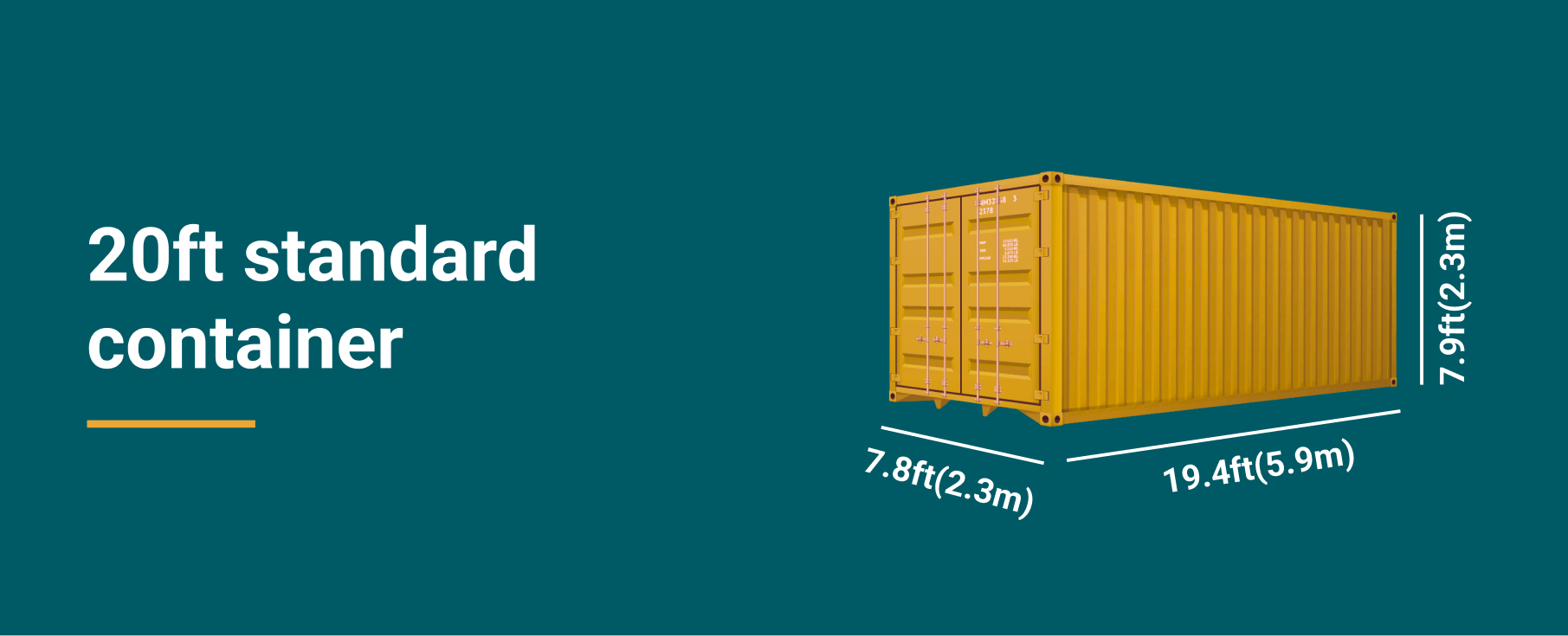
This container size is also popular due to its smaller size. It’s easy to load and unload from ships and can be used at ports without advanced lifting equipment. If you don’t have much cargo, choosing a 20ft standard container is the right choice for you.
20ft standard container dimensions
To get a better idea of the dimensions of a 20ft container, take a look at the table below.
| Measure | 20ft |
| Internal length | 5.9m / 19.4ft |
| Internal width | 2.35m / 7.8ft |
| Internal height | 2.39m / 7.9ft |
| Tare weight | 2,300kg / 5,071.5 lbs |
| Payload capacity | 25,000 kg / 55,126.9 lbs |
| Cubic capacity | 33.2 m3 / 1,172 cu ft |
Since 20ft standard containers are easily available, their prices are not very high. Want to see for yourself? Click here to find out the prices.
40ft standard shipping container
The 40ft container, as the name suggests, is a shipping container that’s twice the size of the 20ft container. It’s also known as forty-foot equivalent unit (FEU) and can carry 23-24 Euro pallets in one tier and 20-21 standard pallets in one tier.
This container is suitable if you have cargo that won’t fit inside a 20ft container. And using one 40ft container is more cost-effective than choosing two 20ft containers. Check out the prices of 40ft standard containers here and see for yourself how 40ft containers are more cost-effective.
40ft standard container dimensions
Take a look at the table below and get a better idea of the dimensions of a 40ft standard container.
| Measure | 40ft container |
| Internal length | 39.5ft / 12.03m |
| Internal width | 7.9ft / 2.4m |
| Internal height | 7.9ft / 2.39m |
| Tare weight | 8,268.8 lbs / 3,750kg |
| Payload capacity | 61,200 lbs / 27,600kg |
| Cubic capacity | 2,389 cu ft / 67.7 m3 |
Before we move forward with other containers, if you want more information on 20ft and 40ft containers, check out this blog post.
High cube standard shipping container
High cube containers are available in two sizes: 40ft high cube and 45ft high cube. Both are similar to 40ft containers in structure but have additional height. These containers provide a great space for your cargo. If your cargo can’t fit inside a 20ft container or a 40ft container, then high cube containers are your ideal choice.
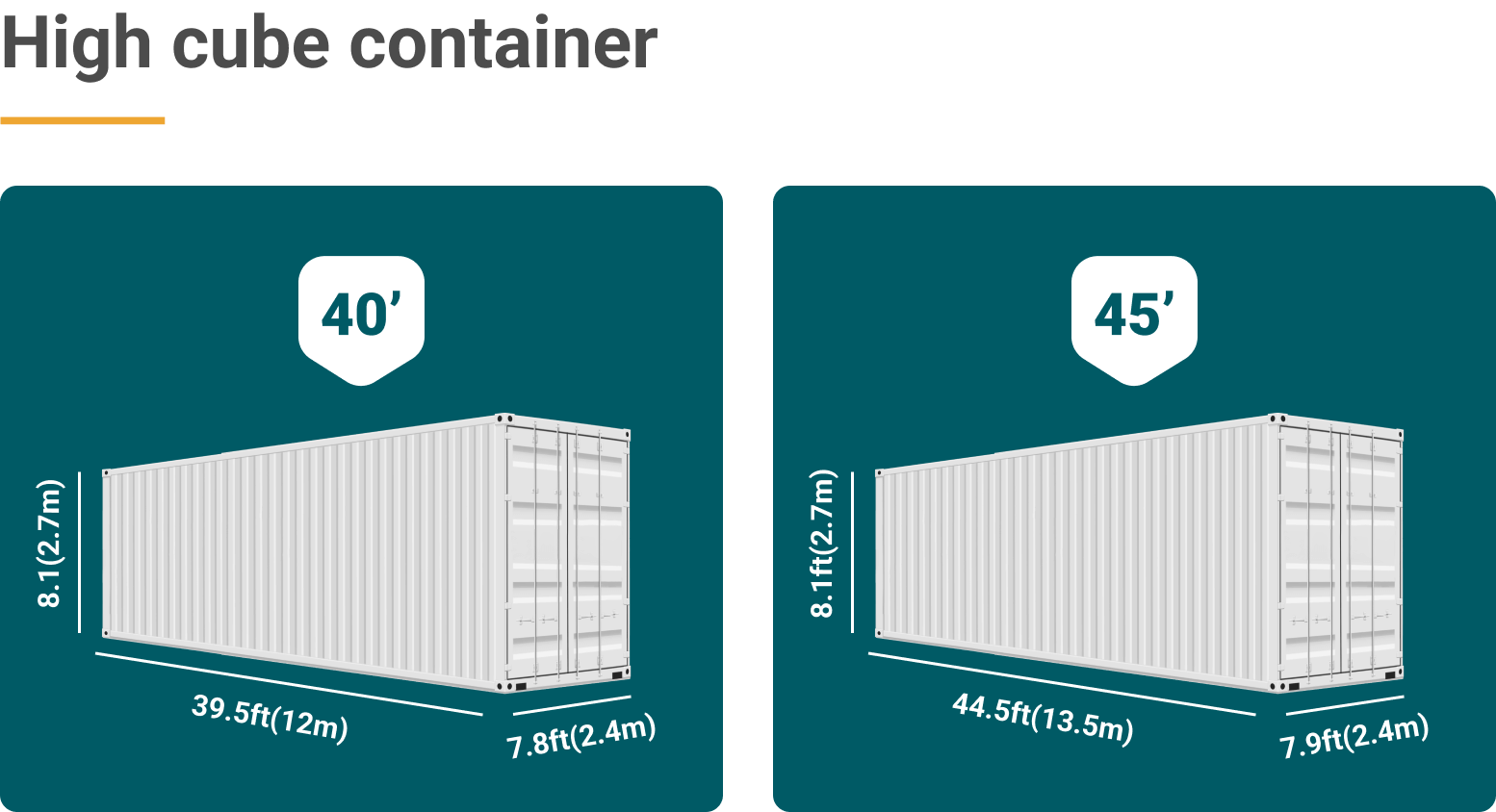
As we discussed above, it’s cost-effective to choose a high cube container than choosing two or more shorter containers. This way, you not only load all your cargo in one container but also save money on the vessel slots.
Want to see the prices of high cube containers in your preferred location? Click here to check out the prices in 2500+ locations globally.
40ft and 45ft high cube standard shipping container dimensions
Take a look at the table below for the dimensions of 40ft and 45ft HC containers.
| Measurements | 40ft HC | 45ft HC |
| Internal length | 12.03m/39.5ft | 13.55m/44.5ft |
| Internal width | 2.35m / 7.8ft | 2.35m / 7.8ft |
| Internal height | 2.70m / 8.10ft | 2.70m / 8.10ft |
| Tare weight | 3,900kg / 8,598 lbs | 4,800kg / 10,552 lbs |
| Payload capacity | 28,600 kg / 63,052 lbs | 27,700kg / 61,067 lbs |
| Cubic capacity | 76.3 m3 / 2,694.5 cu ft | 86 m3 / 3,037 cu ft |
Getting your hands on these standard containers is not an issue. However, you might end up paying more than the current market prices due to a lack of transparency in the industry.
That’s why, on our online container trading platform, we offer 100% market price transparency. Once you submit your requirement, you’ll get multiple offers. You can compare prices from different sellers and choose the best one. We don’t charge any commission on sales, so you can be sure that there are no hidden costs.
Want to get standard containers in 2500+ locations from vetted sellers? Simply click the banner below and start browsing container deals now.
Apart from the standard containers that we’ve discussed, there are also specialized containers. Read on to find out more about them.
Standard dimensions of special containers
Special containers are used to transport specialized cargo. Each special container is designed to transport a specific type of cargo. For example, large machine equipment that can’t fit inside a standard container is shipped using an open top or flat rack container.
Read on to find out more about other container types and dimensions. Find out which type of cargo they’re most suitable for.
Reefer container dimensions
Reefer containers are refrigerated containers. This means you can use them to carry cargo that needs temperature control. These containers can control temperature up to +30 and -30 degrees Celsius. So, if you want to transport meat, fruits, dairy, or vegetables, you use the reefer container and not the standard container.
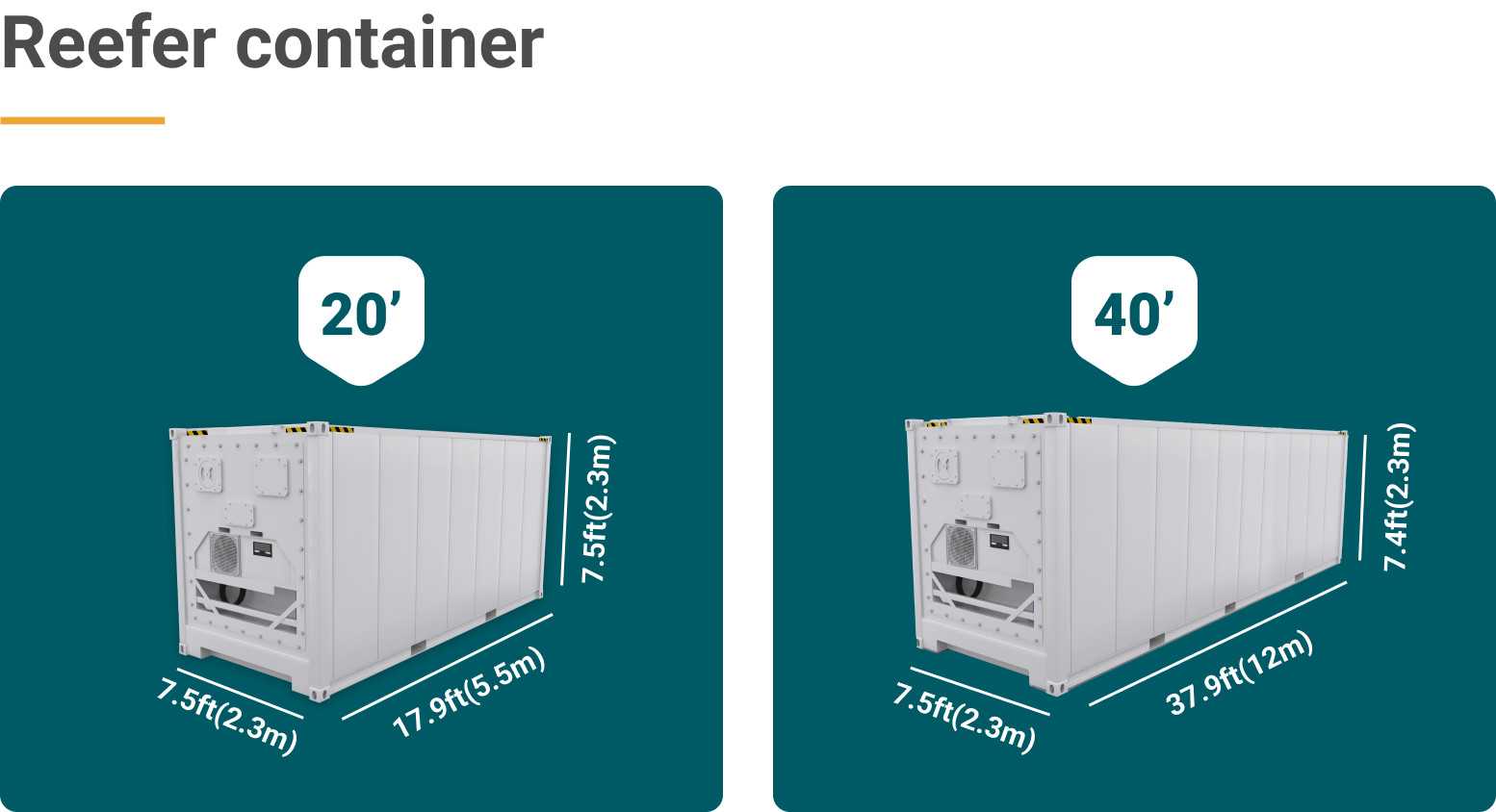
Here are the dimensions of a reefer container.
| Measurements | 20ft | 40ft | 40ft HC |
| Internal length | 5.44m / 17.9ft | 11.56m / 37.9ft | 11.56 m/ 37.9ft |
| Internal width | 2.29m / 7.5ft | 2.28m / 7.5ft | 2.29m / 7.5ft |
| Internal height | 2.27m / 7.5ft | 2.25m / 7.4ft | 2.55m / 8.36ft |
| Tare weight | 3,080kg / 6,791.4 lbs | 4,800kg / 10,584 lbs | 4,480kg / 9,880lbs |
| Payload capacity | 27,400 kg / 60,471 lbs | 27,700 kg / 61,078 lbs | 29,520kg / 65,080 lbs |
| Cubic capacity | 28.3m3 / 999 cu ft | 59.3 m3 / 2,093.3 cu ft | 67.3 m3 / 2,380 cu ft |
Reefers have an integral refrigeration unit and need electrical power points in a container ship. They’re supported by the vessel’s generator. But when they’re on the road, they’re attached to diesel-powered generators for the road. This also makes reefers more expensive. But, you can still find a good price for reefers on our trading marketplace.
Open top container dimensions
Open top containers are specialized containers that don’t have a roof. The roof is either covered with a tarpaulin sheet or left open, as per convenience. This container is ideal to transport oversized or bulky cargos that can’t be loaded through the door. And the ones that don’t fit a regular container.
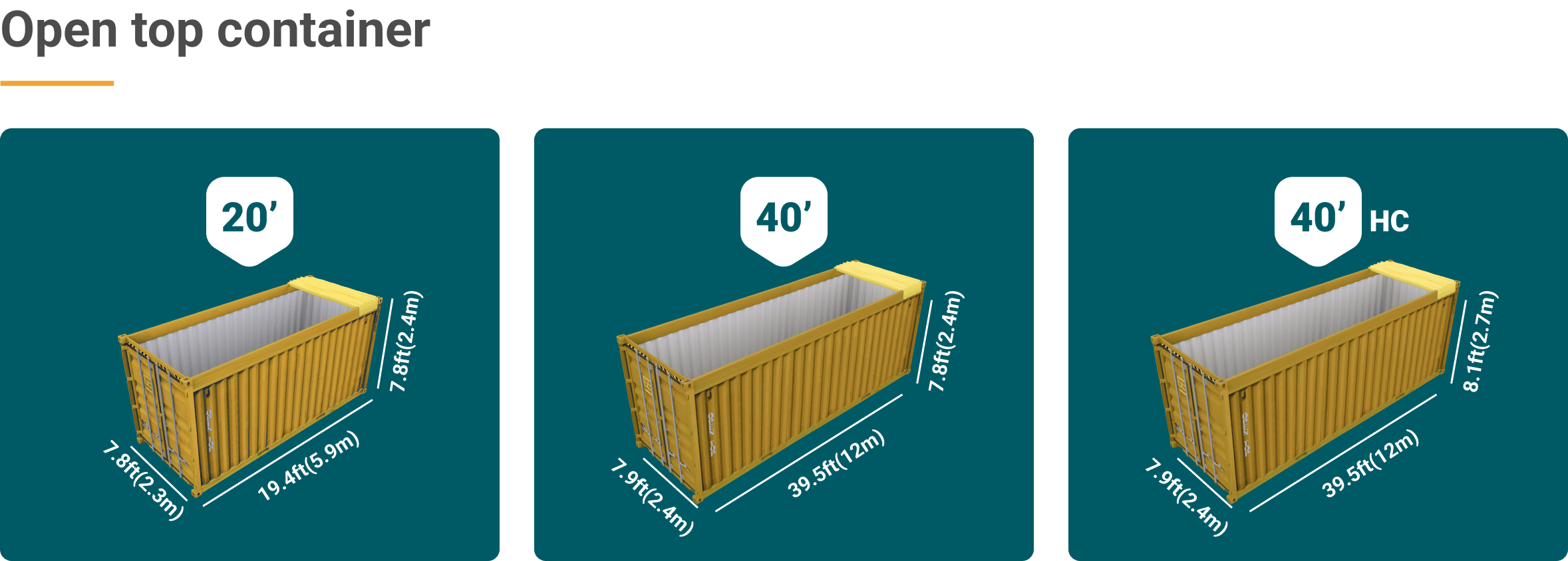
For loading cargo in an open top container, you can use a crane or a rolling bridge. Open top containers have lashing rings, so they keep the cargo stable despite the height and weight of the commodities.
Open top containers come in three sizes: 20ft, 40ft and 40ftHC. Take a look at the table below to get an idea of the measurements.
| Measurements | 20ft | 40ft | 40ft HC |
| Internal length | 5.89m / 19.4ft | 12.03m / 39.5ft | 12.03m / 39.5ft |
| Internal width | 2.35m / 7.8ft | 2.4m / 7.9ft | 2.35m / 7.8ft |
| Internal height | 2.35m / 7.8ft | 2.34m / 7.8ft | 2.70m / 8.10ft |
| Tare weight | 2,260kg / 5,982 lbs | 3,980kg / 8,774 lbs | 4,250kg / 9,370 lbs |
| Payload capacity | 28,220 kg / 62,214 lbs | 26,500kg / 58,422 lbs | 28,250kg / 62,281 lbs |
| Cubic capacity | 32.7 m3 / 1,155 cu ft | 66.7 m3 / 2,356 cu ft | 74.9 m3 / 2,645 cu ft |
Do you have bulky cargo and want to transport it through open-top containers? Check out the prices of open top containers in 2500+ locations globally.
Side door container dimensions
Side door containers, as the name suggests, have doors on the longer side of the container. These containers are suitable if your cargo can’t fit inside the container through the end doors.
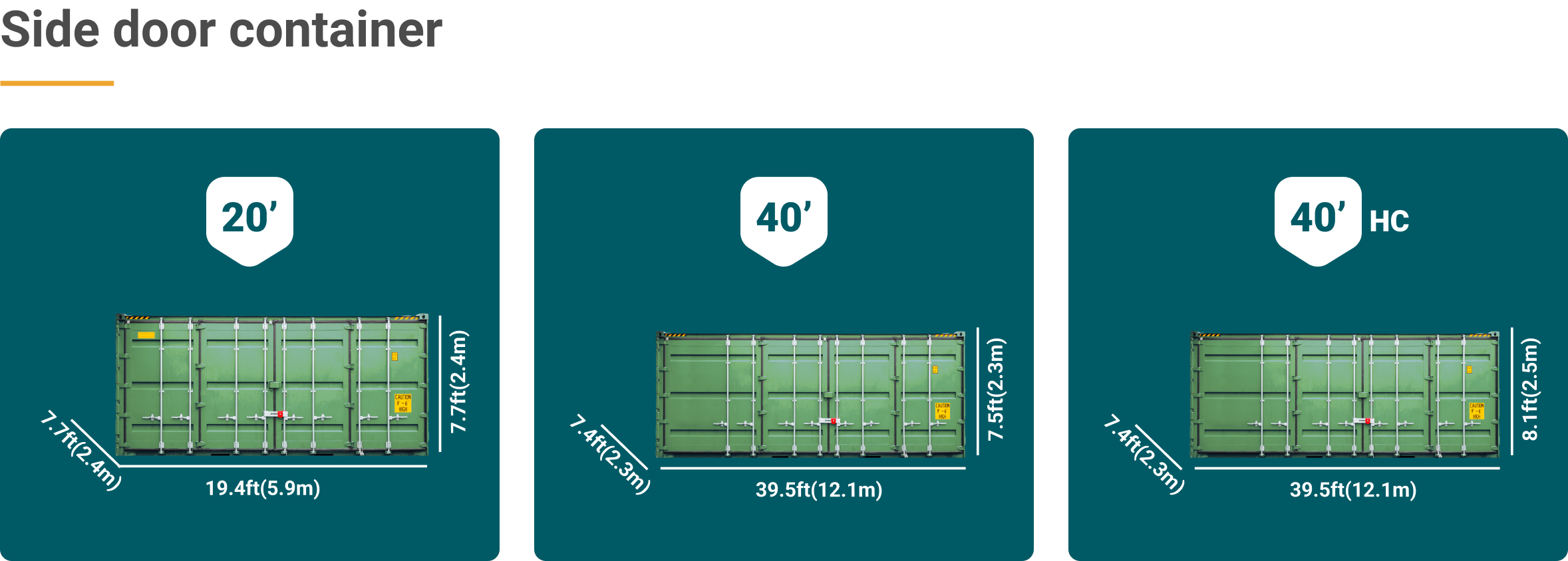
Side door containers also allow workers to easily load and unload the cargo, as the side doors give more access to the container. These containers are also available in three sizes. Take a look at the table below to get their dimensions.
| Measurements | 20ft | 40ft | 40ft HC |
| Internal length | 5.9m / 19.4ft | 12.03m / 39.5ft | 12.03 m / 39.5 ft |
| Internal width | 2.35m / 7.7ft | 2.28m / 7.4ft | 2.34 m / 7.8 ft |
| Internal height | 2.34m / 7.7ft | 2.29m / 7.5ft | 2.69 m / 8.9 ft |
| Tare weight | 2,700 kg / 5,950 lbs | 4,700 kg / 10,362 lbs | 5,200 kg / 11,470 lbs |
| Payload capacity | 27,780 kg / 61,244 lbs | 27,300 kg / 60,180 lbs | 28,600 kg / 63,052 lbs |
| Cubic capacity | 33.0 m3 / 1,165 cu ft | 64 m3 / 2,2306 cu ft | 76.3 m3 / 2,694 ft3 |
Now that you have an idea of standard as well as specialized containers, let’s take a look at how you can buy these containers at the best prices on xChange.
Buy standard shipping containers at xChange
Standard containers are used to transport the majority of cargo. Although these containers are easily available, you might end up paying more for them than the market price. This is because of the lack of price transparency in the industry.
However, at xChange, we offer 100% market transparency to our members. You can easily browse through multiple offers from vetted sellers on our trading platform. We have over 10,000+ containers in 2500+ locations globally. This means there’s a higher chance that you’ll find the containers you’re looking for on xChange than on your current sourcing channel.
And if you’re not happy with the prices, you can negotiate directly with the sellers. We don’t charge any commission on sales so you can be sure that you’re paying the market price (or even less) on xChange.
So are you ready to trade containers at the best price on xChange? Just click the banner below to get started.
Standard shipping container: Common FAQs
What is a standardized container?
A standardized container is the common and basic type of freight container used for shipping cargo. They follow the standards set by the ISO.
What is the standard shipping container’s size?
The standard shipping container’s size varies but the 20ft and 40ft containers (externally) come with a width of 8ft are the most common.
Who was responsible for standardization of containers?
Malcolm McLean, an American businessman, manufactured the modern standard shipping container as we know it now. He created the right container for seamless transportation.
